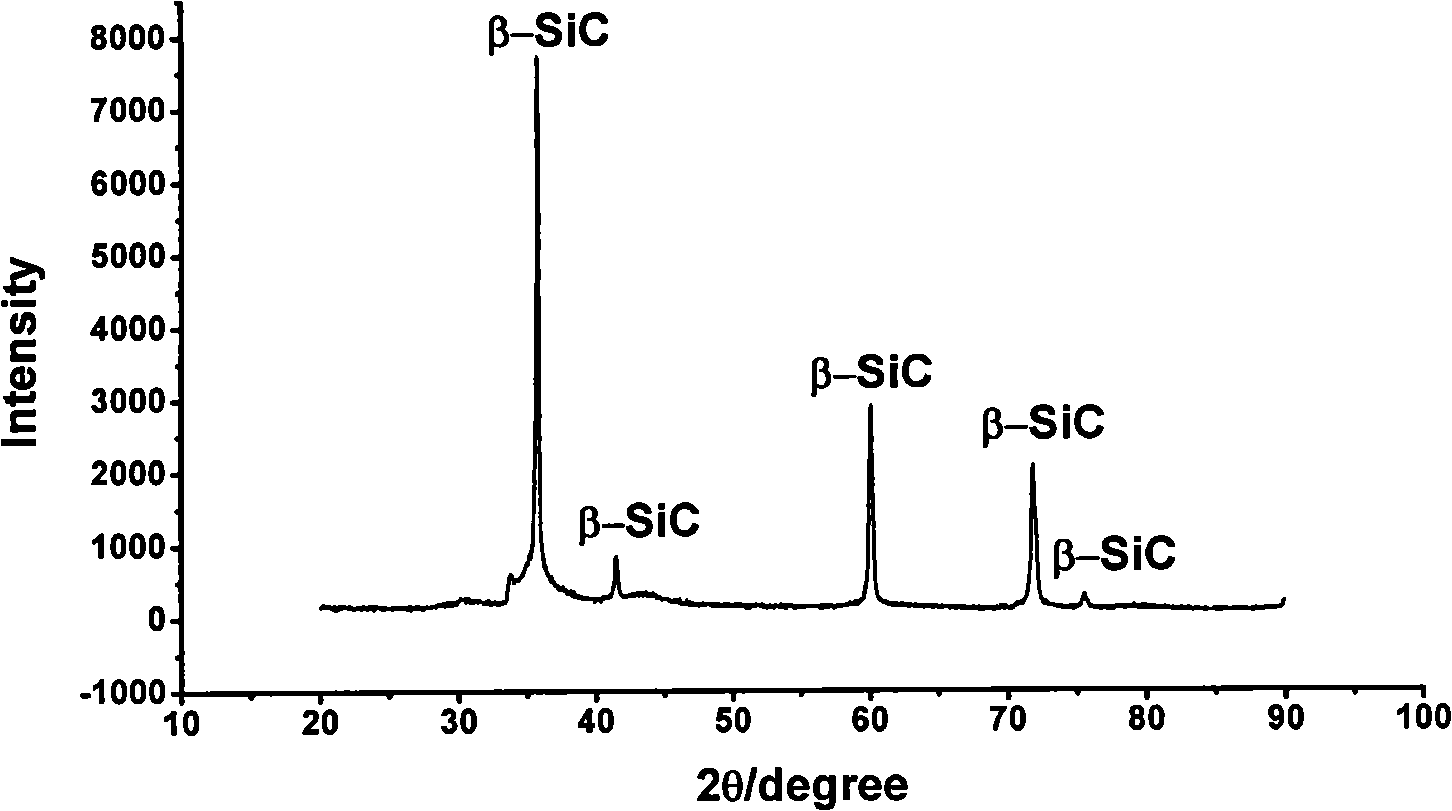Method for synthesizing beta-SiC nano-wire
A synthesis method and nanowire technology, which is applied in the field of synthesis of β-SiC nanowires, can solve the problems of high cost and low purity of β-SiC nanowires, and achieve the effects of high surface activity, high specific surface area, and wide sources
- Summary
- Abstract
- Description
- Claims
- Application Information
AI Technical Summary
Problems solved by technology
Method used
Image
Examples
Embodiment 1
[0013] Embodiment 1: the present embodiment adopts pine wood as biological activated carbon raw material
[0014] 1) Preparation of bioactivated carbon flakes: first process pine wood into flakes with a thickness of 1mm, wash the flakes with water, and dry them in a blast drying oven at a drying temperature of 70°C for 24 hours, and then The dried flakes were carbonized at 900°C, the heating rate was 60°C / h, and kept for 10 hours to obtain biological activated carbon flakes;
[0015] 2) Preparation of reaction powder: mix diatomaceous earth and silicon powder at a mass ratio of 1:1, and ball mill;
[0016] 3) Preparation of β-SiC nanowires: place the reaction powder in a corundum crucible or a graphite crucible, insert a bioactive carbon sheet into the crucible, cover the crucible mouth with carbon felt, put the crucible into a vacuum sintering furnace and heat up to 1400°C, heat preservation for 1 hour, control the furnace pressure below 100Pa, take out the bio-activated car...
Embodiment 2
[0017] Embodiment 2: the present embodiment adopts pine wood as biological activated carbon raw material
[0018] 1) Preparation of biological activated carbon flakes: first process pine wood into flakes with a thickness of 3mm, wash the flakes with water, and dry them in a blast drying oven at a drying temperature of 70°C for 24 hours, and then The dried flakes are carbonized at 1000°C, the heating rate is 30°C / h, and the heat preservation is 8 hours to obtain biological activated carbon flakes;
[0019] 2) Preparation of reaction powder: mix diatomaceous earth and silicon powder at a mass ratio of 1:1.3, and ball mill;
[0020] 3) Preparation of β-SiC nanowires: place the reaction powder in a corundum crucible or a graphite crucible, insert a bioactive carbon sheet into the crucible, cover the crucible mouth with carbon felt, put the crucible into a vacuum sintering furnace and heat up to 1300°C, heat preservation for 1.5 hours, control the furnace pressure below 100Pa, tak...
Embodiment 3
[0021] Embodiment 3: present embodiment adopts moso bamboo as biological activated carbon raw material
[0022] 1) Preparation of biological activated carbon flakes: first process the moso bamboo into flakes with a thickness of 2mm, wash the flakes with water, and dry them in a blast drying oven at a drying temperature of 70°C for 24 hours, and then The dried flakes were carbonized at 930°C, the heating rate was 50°C / h, and they were kept for 9.5 hours to obtain biological activated carbon flakes;
[0023] 2) Preparation of reaction powder: mix diatomaceous earth and silicon powder at a mass ratio of 1:1.5, and ball mill;
[0024] 3) Preparation of β-SiC nanowires: place the reaction powder in a corundum crucible or a graphite crucible, insert a bioactive carbon sheet into the crucible, cover the crucible mouth with carbon felt, put the crucible into a vacuum sintering furnace and heat up to 1200°C, keep warm for 2 hours, control the furnace pressure below 100Pa, take out the...
PUM
| Property | Measurement | Unit |
|---|---|---|
| Thickness | aaaaa | aaaaa |
| Thickness | aaaaa | aaaaa |
| Thickness | aaaaa | aaaaa |
Abstract
Description
Claims
Application Information
 Login to View More
Login to View More - R&D
- Intellectual Property
- Life Sciences
- Materials
- Tech Scout
- Unparalleled Data Quality
- Higher Quality Content
- 60% Fewer Hallucinations
Browse by: Latest US Patents, China's latest patents, Technical Efficacy Thesaurus, Application Domain, Technology Topic, Popular Technical Reports.
© 2025 PatSnap. All rights reserved.Legal|Privacy policy|Modern Slavery Act Transparency Statement|Sitemap|About US| Contact US: help@patsnap.com


